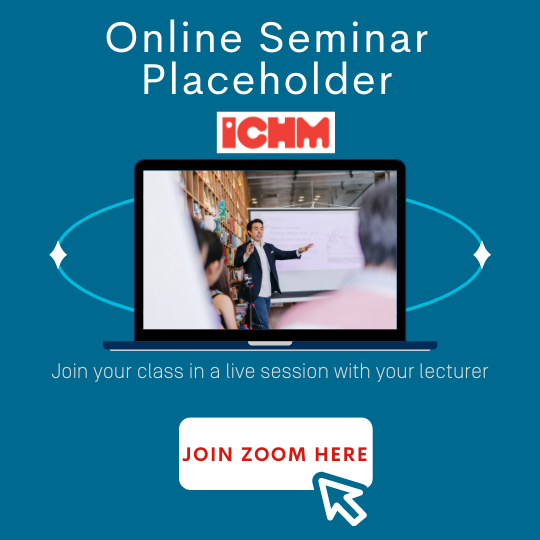Welcome to Topic 5: Effective Online Communication. This topic will engage you in considering how to communicate effectively with an online audience. You will look at the skills needed in meeting, training and working online, and how social media can be a useful tool.
In this topic, you will learn about:
- What online communication is
- Writing formal emails
- Tools for effective online meetings
- Conducting and participating in webinars
- Effective use of social media.
These relate to the Subject Learning Outcomes:
- Discuss the written, verbal, listening and non-verbal communication skills in academic, professional and intercultural settings.
- Outline the critical thinking and academic research skills required to make informed decisions.
- Define the principles and practice of effective presentations and public speaking.
- Build a professional physical and online profile that showcases your knowledge, skills and attributes.
Welcome to your pre-seminar learning tasks for this week. Please ensure you complete these prior to attending your scheduled seminar with your lecturer.
Click on each of the following headings to read more about what is required for each of your pre-seminar learning tasks.
Complete Worksheet 1 – When and what do you write? Be prepared to share your ideas in the discussion forum 'Topic 5: Forum Activity 1'.You can also navigate to the forum by clicking on 'ESK100 Subject Forum' in the navigation bar for this subject.
- Read the prescribed text, Dwyer, J 2019, Business and the professions: Strategies and skills, 7th edn., Pearson Education Australia. pp. 3-7 about communication styles. As you read, consider the following questions and make notes for later activities.
- What are the differences between verbal, non-verbal and graphic communication?
- What is the importance of understanding ‘decoding’?
- What constitutes effective two-way communication?
- What are the seven main elements of communication?
- What are some barriers to effective communication?
- Read the prescribed text, Dwyer, J 2019, Business and the professions: Strategies and skills, 7th edn, Pearson Education Australia pp. 508-513 and complete the email checklist on p. 513. Post your responses to the Forum in a reflection paragraph of 150 words about your experiences on the dos and don’ts listed. Use your reading and checklist to complete Worksheet 2.
- Read the prescribed text, Dwyer, J 2019, Business and the professions: Strategies and skills, 7th edn., Pearson Education Australia pp. 255-258 to understand more about the role and uses of virtual meetings. Make notes and consider the following:
- If emails are different to writing due to their permanency, lack of verbal and visual cues and how they are interpreted, how can online meetings be different to face-to-face meetings? Since 2020, many businesses and organisations have transferred to an online world and it has not all been plain sailing.
- What have you learnt from this transition?
- What advice would you pass on to people starting to use this platform to do business and build professional relationships?
- If emails are different to writing due to their permanency, lack of verbal and visual cues and how they are interpreted, how can online meetings be different to face-to-face meetings? Since 2020, many businesses and organisations have transferred to an online world and it has not all been plain sailing.
- Read the protocols in the article Online meeting etiquette for attendees – A 2021 update and create your own ‘To Do’ list for online meetings to post to the Forum 'Topic 5: Forum Activity 1'. Comment on a minimum of two other posts to give constructive feedback.
- Read the information on What is a webinar and consider what you can do as a learner to make the most out of the meetings and webinars you attend. What can you bring? Make notes to bring to the class discussion.
- Listen to the two talks below, one posted in 2009, and the other in 2018. What is the most noticeable for you about the different opinions expressed in these two talks? Make notes to bring to a class discussion. Bring some key quotes from the talks.
- Read the following articles on social media. Make notes to bring to a class discussion.

What is online communication?
When was the last time you hand wrote and sent a letter? Have you ever? When was the last time you knocked on a friend’s door to have a chat? When was the last time you went to a library to look at books to find information for an assignment? Have you ever done these things, or have you always had some form of electronic screen to help you?
Since early 2020, as a result of the COVID-19 pandemic, we have conducted the majority of our transactions via an online platform. The internet has enabled us to manage education, banking, shopping, health, even our social lives without leaving our residences. All these forms of transactions are part of online communication. Sometimes we use this medium effectively and sometimes, not so much!
While obvious benefits to this form of communication include speed, efficiency, safety, and comfort (Angelova 2017), there are also downsides, especially if we are not careful in our use. Our message can reach far further than we intended in a very short space of time, so we need to be mindful of what we put out there and who it can reach. We can also get unexpected responses from people we do not know, who have mistaken our intention, so it is crucial to evaluate these responses for what they are and not get distracted.
To effectively communicate, we must realise that we are all different in the way we perceive the world and use this understanding as a guide to our communication with othersTony Robbins (n.d.)
Learning task
To understand how much we now use the internet to communicate, talk to older family members to find out what you do that they didn’t at your age, and make a list of how our interactions have moved online in the last 25 years. The following are examples of some behaviours that may have changed significantly:
- Letter writing
- Grocery shopping
- Text messages to friends
- Banking
- Study
- Business meetings
- Reading books
How does online differ from face-to-face communication?
As you’ve seen from the pre-seminar tasks, there are many differences between online and face-to-face communication. Some people prefer one over the other, so it is important to understand the value of both and develop strengths in each of them.
The key difference is a real or perceived lack of connection between the people involved in the interactions. This means relationships need to be built more carefully, and more time is given to maintaining these relationships, even if they remain formal. Differences also occur between live and written interactions.
Written online communication
In writing, particularly at a professional level, it is crucial to read the cues from the other person involved. Start safely, by using formal language, avoiding slang and jokes. Make sure you understand your purpose for writing and respect the time of the reader. Open your communication with appropriate language, use the subject line appropriately and remain mindful that your email could have a much wider audience than you intended.
Give a reason for writing, so that your reader understands who you are. State your requirements or intentions briefly, giving the necessary background information, and no more. If you are including an attachment, reference that as well. This may also help you remember to attach the document!
End your communication with any actions required and an appropriate farewell. Use your full name, not a nickname or shortened form and use the email signature to give your family name, title, position and contact details as required. Proofread your email before you send it. Typos or inappropriacies will stay with your reader and have an impact on how they respond to you.
Look at the email below. Does it adhere to the structure laid out above?
To: alison@greathotel.com
Subject: job application – Front Office staff
Dear Alison
I’m writing to apply for the Front Office staff position advertised at jobs.com on August 25th.
I am currently working as a casual in this position at the Hotel Super in Smith Place and have been employed there since June last year. I am now seeking a more permanent position, which is why I am interested in the role advertised. Please find attached my resume, which details my qualifications and experience, and my cover letter, which states why I am suitable for this position.
As requested in the advertisement, these are attached separately.
I look forward to hearing from you.
Kind regards,
Susan Winn (Ms)
Guest Service
Agent Hotel Super
If Alison replies to Susan, she may use a more informal tone. However, for Susan, as the person applying for the job and aiming to develop their professional relationship, it is a good idea to retain formality until they have met in person (Dwyer 2016).
With any kind of online communication that requires the reader to do something for you, formality will help that action to be achieved. Once formality is broken, it is impossible to go back, and a relationship will be damaged. If you are not sure how appropriate your writing is, have someone check it for you until you are confident that you know what to say and how to say it.
When and what do you write?
Writing is a very different form of communication from speaking. When we speak, however, and we are face-to-face with our audience, our words are not (usually) recorded, and our communication is immediate (Dwyer 2016). We can rely on intonation, volume and body language to confirm our meaning and we can repeat and clarify in real-time, watching the reactions of the people we are talking to.
In writing, we need to make a clear impression and take time to ensure that our message cannot be misinterpreted. The words and language style we use are important and can reveal a great deal about us. In business, our written words can make or break a deal, so it is crucial to understand the impact our writing can have on our audience.
When we talk about writing, this does not have to mean an essay, a report or a speech; it can be a social media post, a text message to a friend or colleague, or even a shopping list. In daily life, we write much more than we think.
Emails and formality
If writing is permanent and cannot easily be clarified in isolation, then what are the implications for communicating via email? Emails are immediate and can be responded to immediately, but they can also be shared immediately, and the wrong message can be transmitted far further than the original sender intended.
Emails can also be very informal, less accurate and more subjective (Akhtar & Riaz 2019), very short, and can have attachments that can be included or forgotten completely. What message is being sent involuntarily if the correct conventions are not respected, either deliberately or inadvertently? Have you ever made a mistake when sending an email?
Communicating online in meetings

In an online meeting, especially with people that need to work together over a period of time, it is tempting to set an agenda and get started. However, this will not build the trust needed for a good working relationship. So, there are different techniques that you can try to build confidence in the online team.
Appoint roles for each meeting. These include a chair and a minute taker. Both of these roles are key to the progression of the meeting and to the actions that need to be followed up between this and the next meeting. These roles can rotate, but it is important for the team to agree on this, or understand that it is not appropriate to all settings.
Prior to the meeting, make sure an agenda has been circulated, as well as minutes from previous meetings. This email can also include the meeting link, the agreed start time and the expected finish time. Let participants know in advance how much time they will need to spend at this meeting.
Make sure that the meeting host and/or chair and minute taker are ready to start the meeting a couple of minutes earlier, so all arrivals can be greeted and acknowledged.
Ensure that as many cameras as possible are turned on and that participants know when they should mute their microphones, so the meeting can proceed smoothly.
The chair should always welcome attendees and make any acknowledgements required, including expectations of attendees such as when to mute themselves and when to ask questions. The chair of the meeting must control or facilitate the discussion thread by private messaging or another agreed upon method to ensure all members are given a chance to have their voice heard (Dwyer 2016). The chair might also ask attendees to use a ‘hand up’ function, or to add questions to the chat. If the meeting is large, it is a good idea to allocate a different person to ‘spot’ questions in the chat and make sure that the speakers are aware of these.
To build relationships within the group, try to have a ‘check-in’ where members can contribute something personal, a feeling, a question, before the formal part of the meeting begins.
Refer to previous minutes and actions required therein – have there been any changes, and does everyone agree with what has been written?
Follow the agenda and keep to time. Manage questions and responses carefully, and keep on track. If people want to talk about other matters, acknowledge and note their requests and let them know that this can be added to the AOB (Any Other Business) section of the meeting or added to the Agenda for the next meeting. Make sure that everyone who speaks is acknowledged so that they feel included in the proceedings and are valued as members of the team. If a person feels excluded in the way they have been responded to, it will quickly break down communication within the team and prevent valuable change or work from occurring.
When the time for the meeting has concluded, ensure that everyone knows when minutes will be distributed when the next meeting will be held, and whether they are required to submit agenda items. Inform participants of when that new agenda can be expected.
Between meeting dates, stay in touch with the group via an online platform such as Teams or Whatsapp, so that concerns, ideas, suggestions, questions can be shared as the work of the team progresses. Allow online or in-person meetings where possible between the formal meeting dates so that relationships can continue to develop. Encourage and facilitate smaller groups of people to work together to produce the work required on the project. Allow and encourage check-ins with members so that there is trust between all members, and listen if there are complaints.
Trouble-shooting
Problems can occur in an online team. Work can be delayed or even stopped altogether if the team is not functioning well. This can happen in a professional situation, but what can you do about it? We will discuss conflict resolution in more detail later in this subject. However, in the meantime, consider allowing time in meetings to air issues and grievances with an open policy of addressing and resolving them. Just because problems are online and not face-to-face does not mean they are any less important. The key to any issue that might arise is to maintain some form of communication (Thompson 2019).
Webinars and online study
A webinar is a class, lecture, or talk that you attend online. You can be part of a small or very large group, be asked to stay muted, and have your camera off or on. There will usually be a chat as part of the tools available, and perhaps a moderator will be present in addition to the main speaker to take your questions and manage the responses that come in from the participants (Torrau 2020).
Webinars are a common forum for study and can have a similar format to meetings, though with perhaps less interaction with the host. Many communication techniques may be similar, including screen sharing, dealing with questions and acknowledging participants.
Social Media

Facebook, Whatsapp, LinkedIn, Instagram, Twitter, Snapchat are all forms of social media that have exploded from their original intentions and permeated every aspect of life. You may have originally signed up in order to stay in touch with friends and family, or to get fast free messaging. Nowadays, social media gives you access to news, opinion, marketing, politics and cost-effective connection with a broad audience base (Mejia 2016). We have to think carefully and critically about what we read on social media, and this should inform what we post as well.
Think about what people are doing on Facebook today. They’re keeping up with their friends and family, but they’re also building an image and identity for themselves, which in a sense is their brand. They’re connecting with the audience that they want to connect to. It’s almost a disadvantage if you’re not on it now.Mark Zuckerberg, Co-founder and CEO of Meta (2009)
Social media can be used and misused both personally and professionally, so it is important to understand how to best use the different platforms you have. Dwyer (2016, p. 43 ) states that these forms of communication have “enhanced communication”, where the previous hierarchies are less noticeable, but can be just as strict in business.
Remember the scope and range of audiences that you may have and learn how to use the privacy settings on your platforms effectively.
Learning task: The dos and don’ts of social media
What are the key things to and not to do when using social media?
Complete Worksheet 3. Consider the different social media platforms you use, and how you use them differently for different audiences.
Online communication is now an intrinsic part of our lives but knowing how to use it in a professional setting may take some time and effort to master. It is important to start thinking like a professional when you send emails or use any online platform for your communication needs. Remember, unlike verbal communication, online communication can often be seen by many people and has far-reaching consequences if inappropriate materials are posted. Continue to refer back to the core concepts discussed in this topic as you embark on your learning journey and look towards your future career path goals.
Knowledge check
Complete the following three (3) tasks. Click the arrows to navigate between the tasks.
Key takeouts
Congratulations, we made it to the end of Topic 5! Some key takeouts from Topic 5:
- Online communication can be harder to develop and maintain than face-to-face interactions.
- Respect levels of formality until relationships are fully developed.
- Remember the scope, breadth, and influence of a potential audience.
- Proofread online communications before you press ‘send’.
Welcome to your seminar for this topic. Your lecturer will start a video stream during your scheduled class time, you can access your scheduled class by clicking on ‘Live Sessions’ found within your navigation bar and locating the relevant day/class or by clicking on the following link and then click 'Join' to enter the class.
Click here to access your seminar.
The learning tasks are listed below, these will be completed during the seminar with your lecturer. Should you be unable to attend, you will be able to watch the recording which can be found via the following link or by navigating to the class through ‘Live Sessions’ via your navigation bar.
Click here to access the recording. (Please note: this will be available shortly after the live session has ended.)

In-seminar learning tasks
The in-seminar learning tasks identified below will be completed during the scheduled seminar. Your lecturer will guide you through these tasks. Click on each of the following headings to read more about the requirements for each of your in-seminar learning tasks.
Working in groups discuss the following questions and concepts:
- What are the protocols around webinars?
- How can you get the most out of these webinars and/or online meetings?
- and how can you contribute the most effectively?
- What can derail the webinars and/or online meeting?
- Have you experienced any behaviours that have upset the smooth running of a webinar?
- Consider what you can do as a learner to make the most out of the meetings and webinars you attend.
- What can you bring?
- In a group, discuss your thoughts about social media. You may like to refer to the notes you have written after watching the two videos in pre-seminar Learning Task 4.
- Collaborate on a blog post that advises on the use and misuse of social media in a business form, via a webinar. Use the notes you have written after reading the two articles for the pre-seminar Learning Task 4.
Welcome to your post-seminar learning tasks for this week. Please ensure you complete these after attending your scheduled seminar with your lecturer. Your lecturer will advise you if any of these are to be completed during your consultation session. Click on each of the following headings to read more about the requirements for each of your post-seminar learning tasks.
This learning task consists of two (2) parts:
Part 1: Write a 150-word reflection in your reflective journal, using what you have read in this subject to inform your perspective. The following questions should help to guide your writing. You can access the reflective journal by clicking on ‘Journal’ in the navigation bar for this subject.
- What online platforms have you used for meetings?
- What are the most useful tools that are in that software, and what advice would you give for people using them for the first time?
Part 2: Based on the work you have done in this subject, what have you learned about online interactions via social media and webinars?
Navigate to 'Topic 5: Forum Activity 2' to complete this task.
Review the requirements for Assessment 1.
You will need to focus on the first of the online activities. Collate your reflections and create a draft version of your initial thoughts.
Each week you will have a consultation session which will be facilitated by your lecturer. You can join in and work with your peers on activities relating to this subject. These session times and activities will be communicated to you by your lecturer each week. Your lecturer will start a video stream during your scheduled class time, you can access your scheduled class by clicking on ‘Live Sessions’ found within your navigation bar and locating the relevant day/class or by clicking on the following link and then click 'Join' to enter the class.
Click here to access your seminar.
Should you be unable to attend, you will be able to watch the recording which can be found via the following link or by navigating to the class through ‘Live Sessions’ via your navigation bar.
Click here to access the recording. (Please note: this will be available shortly after the live session has ended.)

- Dwyer, J 2016, Communication for business and the professions: Strategies and skills, Pearson. pp. 242-243 and pp. 508-512.
References
- Akhtar, R & Riaz, M 2019, Formality in Academic Writing: Investigating Stylistic Competence of Undergraduate EFL Learners, Faculty of Social Sciences and Humanities University of Wah, Wah Cantt, 1.
- Angelova, N, Kiryakova, G & Yordanova, L 2017, ‘The great impact of internet of things on business’, Trakia, Journal of Sciences, 15(1):406-412.
- Dwyer, J 2016, Communication for business and the professions: Strategies and skills, Pearson.
- Mejia, AM 2016, Assessing the relationship between higher education leadership behaviors and professional social media use, PhD Thesis, Texas A&M University-Corpus Christi.
- Schwantes, M n.d., Here's to Tony Robbins advice on how to dramatically improve your communication skills, Inc., https://www.inc.com/marcel-schwantes/heres-tony-robbins-advice-on-how-to-dramatically-improve-your-communication-skills.html
- Thompson, EG 2019, Team Troubleshooting: A Collaborative Approach to Public Library Tech Support, DigitalCommons
- Torrau, S 2020, ‘Exploring Teaching and Learning about the Corona Crisis in Social Studies Webinars: A Case Study’, Journal of Social Science Education, 19(SI):15-29.
- Wired 2009, The wired interview: Facebook's Mark Zuckerberg, Wired, https://www.wired.com/2009/06/mark-zuckerberg-speaks/

